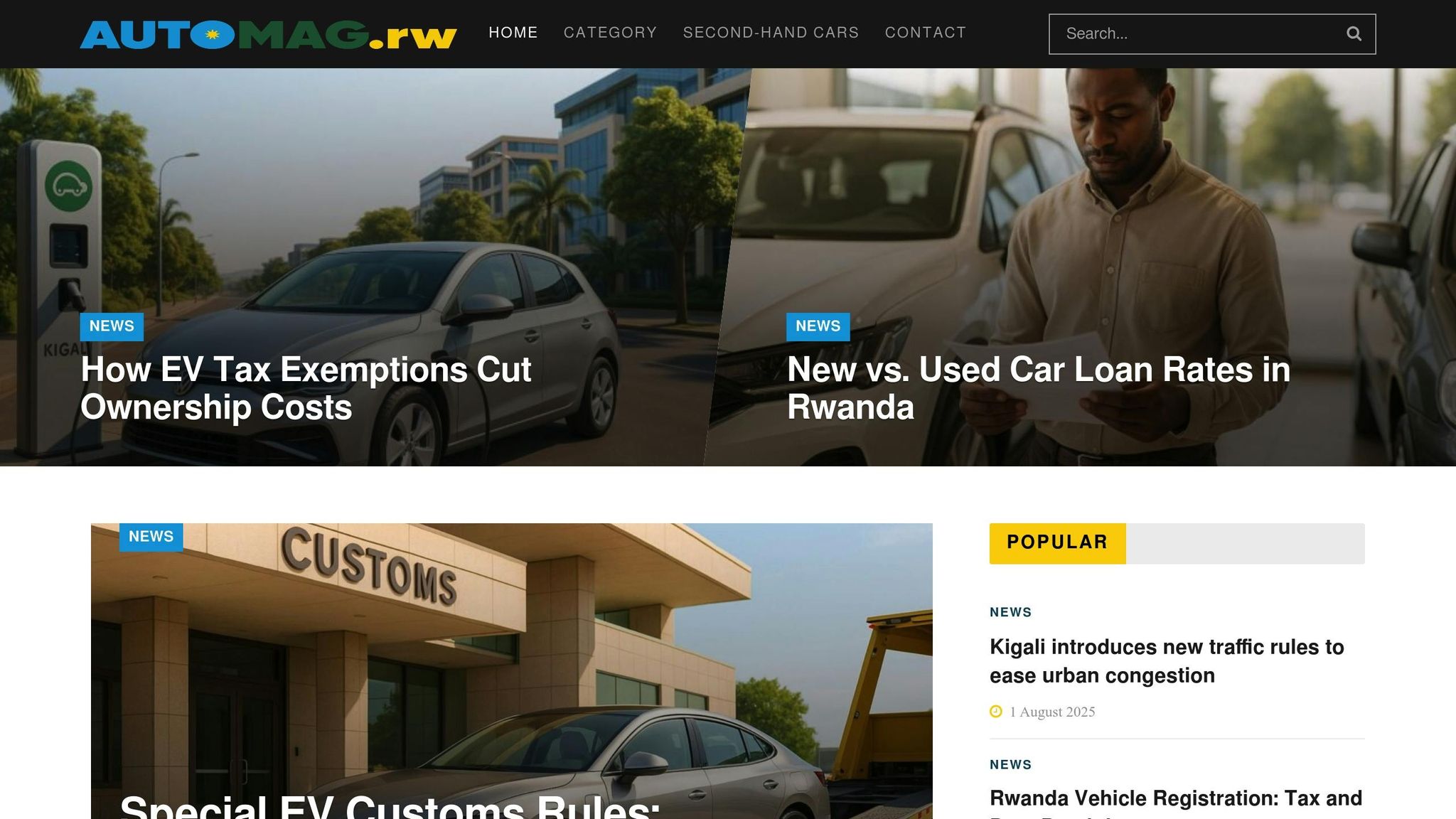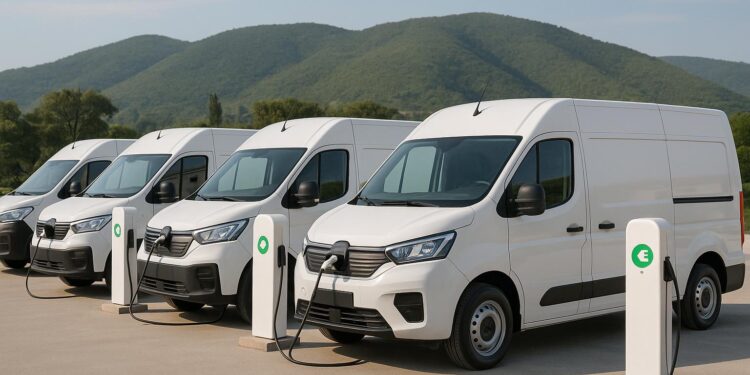Switching your business fleet to electric vehicles (EVs) in Rwanda is easier than ever, thanks to government incentives, reduced costs, and growing infrastructure. Here’s what you need to know:
- Understand EV Benefits: Lower fuel and maintenance costs, improved reliability, and a cleaner image for your business.
- Assess Fleet Needs: Analyze travel distances, routes, and cargo requirements to choose the right EV models.
- Explore Rwanda’s EV Market: Options range from urban-friendly models like the BYD Dolphin to long-range vehicles like Tesla.
- Train Your Team: Teach drivers about EV operations, charging procedures, and maintenance basics.
- Plan Charging Infrastructure: Decide between in-depot charging, public fast-charging, or battery swap stations.
- Leverage Incentives: Take advantage of Rwanda’s new EV tax reforms, effective July 2025, to reduce costs.
- Ensure Compliance: Register vehicles, meet updated emissions standards, and stay informed about new traffic rules.
Transitioning to EVs is a smart move for businesses looking to cut costs and align with Rwanda’s clean transportation goals. Start with a clear plan, train your team, and use local resources like AUTO24.rw for a smooth switch.
Transitioning Your Fleet to Electric Vehicles: Key Insights and Strategies
Assess Fleet Needs and Business Requirements
Take a close look at how your current fleet operates to choose electric vehicle (EV) models that align with your business goals and daily demands.
Analyze Current Fleet Usage and Vehicle Needs
Start by examining your fleet’s daily activities – how far vehicles travel, the routes they take, and the type of cargo they carry. These details will help you pinpoint the EV features that are most important for your operations.
For example, urban routes can benefit from EVs with regenerative braking systems, which improve efficiency in stop-and-go traffic. On the other hand, long rural routes require EVs with extended range capabilities. Additionally, make sure the payload capacity of the EV matches your cargo requirements to avoid operational hiccups.
Find Suitable EV Models Available in Rwanda
Rwanda’s EV market is steadily growing, offering a variety of models to meet different business needs. Platforms like AUTO24.rw now provide access to a range of EVs, making it easier to find options that fit your fleet’s roles.
For long-distance and executive travel, Tesla models are a great choice, while vehicles like the BYD Dolphin and Leapmotor are more suited for urban operations and cost-conscious businesses. If your operations involve transporting goods, consider electric vans or light trucks designed for cargo handling. These vehicles not only meet payload demands but also bring the efficiency and lower running costs of electric powertrains.
By matching EV models to specific tasks within your fleet, you can achieve better performance and cost efficiency.
Train Staff for EV Operations
Switching to an EV fleet requires well-prepared drivers and staff. Training should start with explaining the key differences between EVs and traditional vehicles, such as smoother acceleration, quieter operation, and the use of regenerative braking systems. This will help drivers feel more confident behind the wheel.
Charging procedures are another critical area. Teach drivers how to properly connect charging cables, monitor charging indicators, and plan charging times effectively. Hands-on practice is key to building confidence and familiarity with these processes.
Drivers also need to understand range management and trip planning. EVs demand careful planning around charging stops, so ensure they know how to use vehicle displays and mobile apps to monitor battery levels and locate charging stations.
Basic maintenance training is equally important. Cover essentials like checking tire pressure, monitoring braking performance, and handling simple troubleshooting. Establish clear emergency protocols for issues like low battery levels or charging delays.
Finally, make training an ongoing process. Schedule regular refresher sessions to keep your team updated on new EV features, charging solutions, and best practices. This not only ensures smooth operations but also helps your fleet adapt as it grows and technology advances.
Calculate Costs and Government Incentives
Understanding the costs of owning an EV fleet is crucial for making informed decisions. A clear cost breakdown also helps you take advantage of government programs aimed at lowering the overall investment in electric vehicles.
Calculate Total EV Fleet Ownership Costs
The initial costs of an EV fleet include the purchase price, taxes, and fees. As of October 2025, here’s a snapshot of EV pricing in Rwanda:
- GAC Aion Y Plus 2024: Approximately $25,400 (33,000,000 RWF)
- Hongqi E-QM5 2024: Approximately $26,900 (35,000,000 RWF)
- BYD SongPlus 2025: Approximately $33,500 (43,600,000 RWF)
- ROX 01 2025: Approximately $73,000 (95,000,000 RWF)
Apply for Rwandan Government Incentives
On July 1, 2025, Rwanda introduced bold EV tax reforms to encourage the transition to sustainable transportation. These reforms can significantly benefit businesses adopting EV fleets. To ensure eligibility, consult your EV dealer and gather the necessary documentation for the application process.
Install Charging Infrastructure
Charging infrastructure plays a key role in fleet uptime, expenses, and daily operations. Before diving into installation, take a moment to explore your options.
Compare Charging Options for Business Fleets
Businesses in Rwanda have a variety of charging solutions to choose from, each tailored to different operational needs and budgets:
- In-depot charging: Perfect for fleets with predictable schedules. On-site chargers give you more control over when and how your vehicles charge.
- Public fast-charging: Tap into Rwanda’s growing network of charging stations, especially in Kigali and nearby areas. This option requires less upfront investment but may come with higher per-charge costs.
- Battery swap stations: A quick way to keep vehicles on the road. Drivers can exchange drained batteries for fully charged ones, minimizing downtime. For instance, in February 2024, AUTO24.rw launched an Electric Vehicle Swap Initiative in Rwanda, provided the vehicle supports battery swapping.
Plan Charging Installation and Site Preparation
Once you’ve settled on a charging option, the next step is to prepare your site. Start with an electrical assessment and consult a certified electrician to check whether your existing panel or wiring needs upgrades.
Design a layout that makes chargers easily accessible while ensuring enough space for vehicles. Think about weather protection, proper lighting, and security measures to safeguard your equipment. Collaborating with certified installers is crucial to meet local codes and regulations. Keep in mind that costs and timelines for installation can vary depending on the complexity of your setup and any required electrical updates.
Set Up Maintenance and Support for Charging Systems
To keep your charging infrastructure running smoothly, create a maintenance plan based on manufacturer recommendations. Equip your team with basic troubleshooting skills and build relationships with service providers who can offer quick support when needed. Proactive care ensures your EV fleet stays on the move with minimal disruptions.
sbb-itb-7bc66b5
Handle Registration and Compliance Requirements
Getting your electric vehicle (EV) fleet legally compliant in Rwanda involves navigating registration processes, setting up effective management systems, and preparing your team for safe and efficient operations. This is especially important as Rwanda continues to advance its push toward cleaner and more sustainable transportation.
Register EVs and Meet Legal Requirements
Registering vehicles in Rwanda generally follows standard procedures, but EV fleet owners need to pay close attention to recent policy updates tailored specifically for electric vehicles. Starting July 1, 2025, the Bold EV Tax Reforms have introduced changes to registration and import requirements. Understanding the tax and duty structure tied to these reforms is critical when planning your fleet transition. Additionally, thoroughly review Rwanda’s import procedures, associated costs, and required documentation to avoid potential delays.
Although EVs produce zero tailpipe emissions, Rwanda’s 2025 emissions standards have introduced updated testing protocols and eligibility criteria. Compliance with these standards is mandatory to avoid fines or operational disruptions.
Don’t forget to stay informed about general traffic regulations. For instance, new traffic rules implemented in Kigali as of August 1, 2025, apply to EV fleets just like other commercial vehicles. Ensuring that your drivers are aware of these updates is essential for smooth operations.
Once you’ve addressed registration and compliance, the next step is setting up digital tools to manage your fleet effectively and stay aligned with regulations.
Set Up Fleet Management Tools and Support Services
After completing the legal compliance process, focus on integrating digital fleet management systems to optimize your operations. These systems are specifically designed to meet the unique needs of EVs, helping you monitor vehicle performance, schedule maintenance, and manage charging routines. By streamlining these tasks, you not only boost operational efficiency but also ensure your fleet remains compliant with any new regulations.
Create Maintenance Plans and Safety Training
Maintaining EVs requires a different approach than traditional vehicles, as they rely on specialized components and systems. Develop a comprehensive maintenance plan that includes regular battery checks, software updates, and electrical inspections. While EVs typically need less frequent servicing, their unique technology demands expert attention.
Safety training is equally vital when working with high-voltage systems. Ensure that both drivers and maintenance staff are trained in EV-specific procedures, such as handling charging equipment, executing emergency shutdowns, and responding to accidents. Establish partnerships with certified EV technicians and service centers to ensure your fleet gets expert care. Additionally, maintain a digital log for each vehicle to track maintenance activities, warranty coverage, and compliance with manufacturer guidelines. This documentation will help keep your fleet running smoothly and aligned with regulatory standards.
Use Local Resources for EV Fleet Transition
When planning and setting up your EV fleet, tapping into local resources can make the entire process smoother – from gathering insights to procuring vehicles. Rwanda’s growing EV market offers platforms designed to provide up-to-date information and easy purchasing solutions.
Stay Updated with AutoMag.RW

AutoMag.RW is a go-to source for automotive news and updates on green transportation in Rwanda. For businesses transitioning to EV fleets, this platform is invaluable. It keeps you informed about government incentives, updates on emissions standards, and best practices for charging infrastructure. By regularly consulting AutoMag.RW, you can stay ahead of EV tax reforms and developments in Rwanda’s EV ecosystem.
While AutoMag.RW ensures you’re well-informed, AUTO24.rw helps you take the next step by providing access to the vehicles you need.
Purchase EVs Through AUTO24.rw

AUTO24.rw stands out as a top platform for buying EVs in Rwanda, offering a range of services to support your fleet transition. Their inventory includes both new and certified used EV models from well-known brands, catering to a variety of needs and budgets.
To simplify fleet acquisition, AUTO24.rw provides additional services such as financing options, insurance arrangements, 100-point vehicle inspections, diagnostic services, and VIN verification. Buyers also benefit from a 6-month mechanical warranty on non-wear-and-tear parts and a 5-day refund policy.
Beyond vehicle sales, AUTO24.rw actively supports Rwanda’s shift to sustainable transport. In February 2024, the platform expanded into Rwanda and launched an Electric Vehicle Swap Initiative, further showcasing its commitment to green solutions. Their inventory features brands like ROX, Hongqi, GAC Aion, BYD, and Tesla, offering a wide range of options to suit different specifications and price points.
Key Steps for EV Fleet Transition Success
Transitioning to an electric vehicle (EV) fleet takes thoughtful planning and execution across several areas. One of the first steps is taking full advantage of Rwanda’s Bold EV Tax Reforms, which came into effect on July 1, 2025. These reforms are designed to make EV purchases more affordable, offering businesses a chance to significantly cut costs when adopting electric fleets.
Once tax incentives are factored in, the next priority is infrastructure planning. Rwanda is actively expanding its EV charging network, particularly in Kigali and surrounding areas. Businesses should carefully map out their charging needs, including site preparation, ensuring sufficient electrical capacity, and setting up maintenance protocols for charging stations.
Managing costs effectively is another essential component. Tools like the Electricity Price Tracker can help monitor operational expenses, while government incentives and local financing options further strengthen the financial appeal of switching to EVs.
To minimize risks during the transition, businesses can tap into local expertise and services. This includes support like mechanical warranties and diagnostic assistance, which can address potential challenges early on.
Finally, success hinges on training staff and implementing fleet management systems. Clear protocols for maintenance, safety, and daily operations ensure smooth functioning, reduce downtime, and keep vehicles running at peak performance.
FAQs
What should Rwandan businesses consider when choosing electric vehicles for their fleet?
When choosing electric vehicles (EVs) for your business fleet in Rwanda, there are a few essential factors to weigh. First, look at the driving range of the EVs to ensure they can handle your fleet’s daily routes without interruptions. It’s also crucial to examine the charging infrastructure in your area – check for accessible charging stations and ensure they’re compatible with the vehicles you’re considering.
Another key consideration is the total cost of ownership. This includes not just the purchase price, but also ongoing costs like maintenance and energy consumption. Make sure the switch fits within your budget. Lastly, review the availability of EV models in Rwanda. Options like Tesla, Leapmotor, and ROX offer a variety of designs and performance levels to meet different needs. Picking the right EVs can enhance your fleet’s efficiency while contributing to environmentally friendly practices.
What steps can businesses take to effectively train their staff for managing and operating an electric vehicle (EV) fleet?
To prepare your team for the successful management and operation of an electric vehicle (EV) fleet, it’s important to focus on a few essential areas:
- EV-specific training: Train drivers and fleet managers on the unique aspects of EVs, like charging processes, battery care, and techniques to enhance energy efficiency. Understanding these differences is crucial for smooth operations.
- Safety protocols: Teach your staff the key safety measures for EVs. This includes handling high-voltage components and knowing how to respond to emergencies involving electric vehicles.
- Hands-on experience: Practical experience can make a big difference. Let employees get behind the wheel for test drives and participate in demonstrations to build their confidence and skills.
- Manufacturer resources: Tap into training programs or materials provided by EV manufacturers. These resources are often tailored to specific vehicles and can be incredibly useful for your team.
By focusing on these training areas, businesses can ensure a seamless transition to EVs while prioritizing efficiency and safety in fleet management.
What are the key steps to set up charging stations for an EV fleet in Rwanda?
To establish a charging infrastructure for an electric vehicle (EV) fleet in Rwanda, here’s a practical guide to get started:
- Understand your fleet’s charging needs: Start by evaluating the size of your EV fleet, the vehicles’ driving ranges, and how frequently they’ll require charging. This will help you figure out the number and type of chargers you’ll need.
- Pick the right locations: Look for convenient spots such as company facilities, public parking areas, or busy locations where charging stations can be easily accessed.
- Collaborate with local professionals: Partner with licensed installers or service providers in Rwanda to ensure the charging stations are safe, compliant with regulations, and compatible with your EV models.
- Handle permits and approvals: Check with local authorities and secure any permits required to install the infrastructure.
- Plan for growth: Design the system with room for expansion so it can keep up as your fleet grows.
By addressing these steps, businesses can set up a reliable charging network that supports their EV fleet’s transition smoothly and efficiently.





